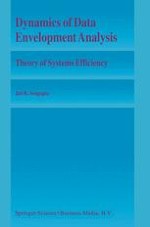1995 | OriginalPaper | Buchkapitel
Stochastic Efficiency
verfasst von : Jati K. Sengupta
Erschienen in: Dynamics of Data Envelopment Analysis
Verlag: Springer Netherlands
Enthalten in: Professional Book Archive
Aktivieren Sie unsere intelligente Suche, um passende Fachinhalte oder Patente zu finden.
Wählen Sie Textabschnitte aus um mit Künstlicher Intelligenz passenden Patente zu finden. powered by
Markieren Sie Textabschnitte, um KI-gestützt weitere passende Inhalte zu finden. powered by
Efficiency measurement in data envelopment analysis (DEA) has mostly used deterministic models, where the input-output data D = (X,Y) are assumed to be known. Here the input and output matrices (X,Y) are deterministic. If a particular decision-making unit (DMU) e.g., DMUk is found to be efficient by a certain type of DEA model, one could aggregate these efficient units into a number N1, where N2 = N - N1 would then be the total number of inefficient units in the total industry comprising N units. The proportion p = N1/N of efficient units provides in this framework a natural measure of efficiency in the whole industry. When one considers time series data Dt =(Xt,Yt), two additional dimensions are introduced. One is due to the wider choice of DEA formulations e.g., one may specify a DEA model for each t and then observe how pt = N1t/Nt changes over time. Alternatively, one may take a cumulative volume of input and output Dc =(Xc,Yc) over a certain period and then apply a DEA model based on the data set Dc to measure efficiency of a DMUk. A second problem is due to the nonstationary nature of input-output data particularly for growing firms or DMUs. In such a case the steady state (t -→ ∞) version of the DEA model may not be valid.
